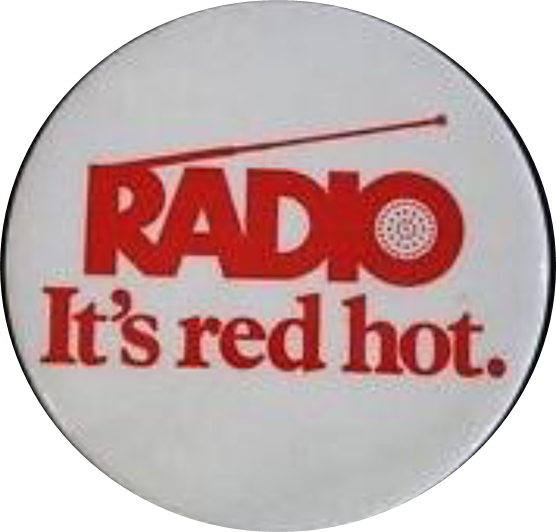
You’d have to be a 40 year radio veteran to remember the clever slogan depickted above. It was actually a mega-effort for the RAB circa 1980, created by the famous production and imaging team, Dick and Bert. And as the slogan suggested, the campaign was designed to remind advertisers about radio’s widespread appeal.
A lot has changed over the years, but broadcast radio (we now need to make that distinction because of digital, satellite, and all the other forms of “radio”) and its state of health is always a major topic of conversation, especially at events like the NAB Show. wrapping up after a week of festivities in Las Vegas.
Among those who did not attend this year, the question always boils down to this:
“So, what was the mood at the NAB this year?”
And I would have to answer “guarded.” On the one hand, many broadcasters feel they’re on course – providing traditional content along with an increased menu of digital offerings. But on the other, research continues to show more traction for radio’s competitors.
And there are fewer radios in the home than ever, especially among young consumers. Will smart speakers save the day for broadcast radio OR will it just allow consumers to access streams and other content at home and on the job?
Earlier this month, Bob Pittman was interviewed by NBC News’ Claire Atkinson. Bob extolled the virtues of radio, of course, but also addressed the  broader audio platform, including smart speakers, his company’s purchase of Stuff Works, as well as streaming audio.His money quote?
broader audio platform, including smart speakers, his company’s purchase of Stuff Works, as well as streaming audio.His money quote?
“Audio is hot for the first time in decades.”
And he’s right. It’s noteworthy the adverb “hot” continues to be used decades later to describe something that is at a high level of popularity.
Not to parse his quote, but it’s notable he’s talking about audio. Radio, to be sure, is under that umbrella. But in this case, it’s part of the larger tech family that includes all the other components of audio.
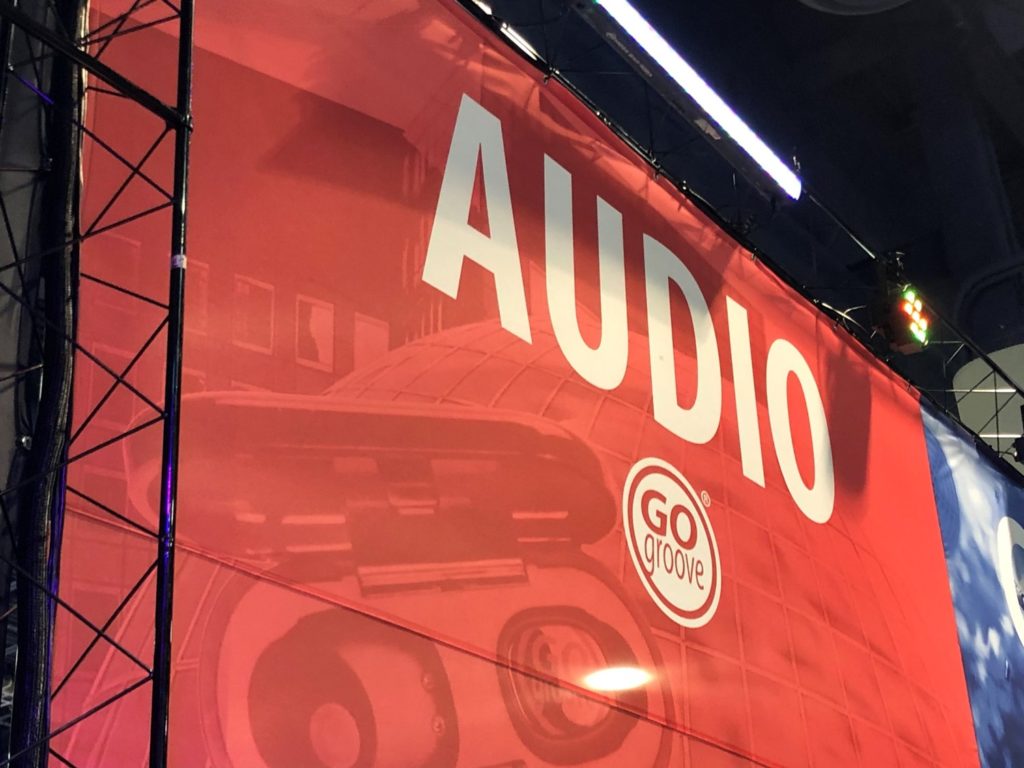 And that brings us to today’s blog topic – the broadcast radio’s struggle to be the life of the audio party. As we heard in session after session, podcasts, smart speakers (let’s start calling it “voice”), wireless Bluetooth earbuds (“heaerables”), and connected cars are all fast-rising platforms or gadgets that bring more audio to consumers in increasingly friction-less ways.
And that brings us to today’s blog topic – the broadcast radio’s struggle to be the life of the audio party. As we heard in session after session, podcasts, smart speakers (let’s start calling it “voice”), wireless Bluetooth earbuds (“heaerables”), and connected cars are all fast-rising platforms or gadgets that bring more audio to consumers in increasingly friction-less ways.
Let’s look at what’s hot in the audio space and why radio struggles.
What’s hot? Podcasting.
Study after study show that more people are discovering podcasts. And podcast listeners are spending more and more time with audio on-demand.
But as James Cridland accurately pointed out in our NAB session, “Fast Tracking Radio’s Future,” podcasting in the U.S. is very much “a public radio thing.” He would know – you’d be hard-pressed to think of anyone in the industry with a better global perspective than futurist Cridland.
Public radio has been at the ground level of podcasts, and its various networks, its sensational talent, and its great storytelling abilities explain why this iis so. We see it in our Techsurveys – public radio fans in our PRTS study (35%) are much more likely to be weekly podcast listeners, compared to those who favor commercial radio (21%).
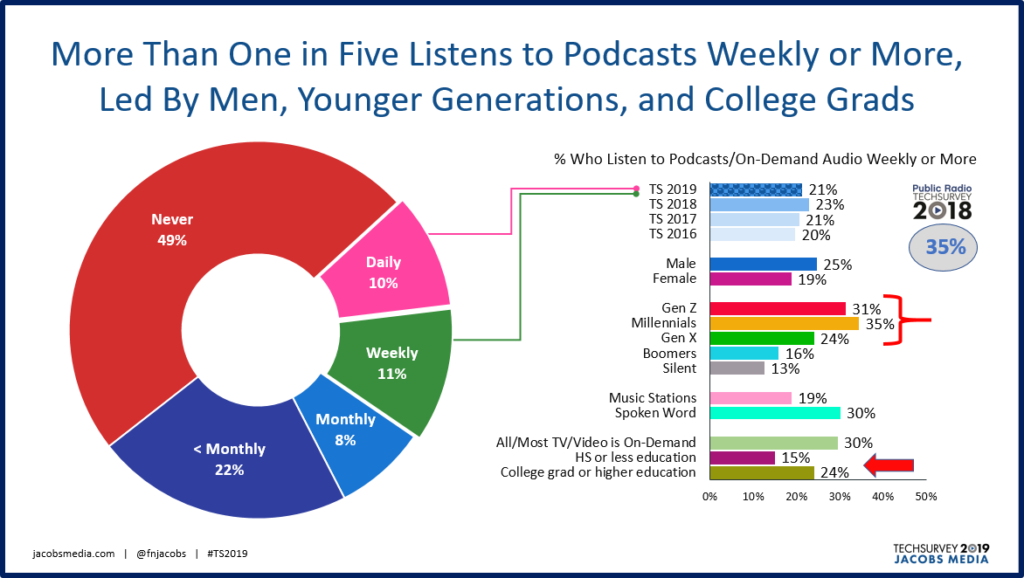
And look at the very bottom of the slide where I’ve highlighted education and the role it plays in podcast listening. At least here in the U.S., college grads ar much more likely to be regular podcast listeners.
And where are college grads? Listening to public radio. By a mile.
Podcasting: Why radio struggles.
From the commercial radio side of the street, audience demography (specifically, education) account for some of commercial radio’s ability to cash in on podcasting by creating appealing content at the station/cluster level. But you might also make a case that after a decade of PPM rules being seared into the brains of programmers and talent – “Keep it short,” “Be brief,” “Focus, focus, focus” – making the leap to longform audio is a tough putt.
We may see more moves like Hubbard. E.W. Scripps, and iHeart – investing in or purchasing existing podcast assets from companies that have established their expertise and have successfully built on-demand audio assets in the space.
Another speed bump revolves around monetization. As radio broadcasters are learning, podcasting isn’t like radio back in the 70s, when a strong AQH and market share was a guarantee of revenue. Nor is it as simply as launching a new format in a marketplace where there are a couple dozen competitors.
There are now north of 700,000 podcasts in this expanding media flea market, making it increasingly more difficult to be discovered. In much the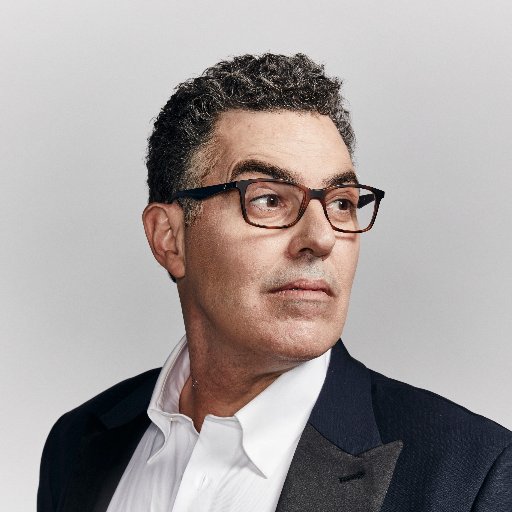 same way broadcasters had to learn patience and discipline when launching a Classic Rock or Country format, so do they need to tap the brakes when their podcast ventures don’t reap a quick windfall. Podcasters like Joe Rogan, Marc Maron, and Adam Carolla (right) are amazingly talented. They were also early in the space.
same way broadcasters had to learn patience and discipline when launching a Classic Rock or Country format, so do they need to tap the brakes when their podcast ventures don’t reap a quick windfall. Podcasters like Joe Rogan, Marc Maron, and Adam Carolla (right) are amazingly talented. They were also early in the space.
Unless a radio operator gets lucky (or buys their way into contention), the podcasting space appears to have all the potential in the world to provide ROI. But it will likely be a marathon, not a sprint.
What’s hot? Smart speakers and voice.
No question about it – the percentage of smart speaker homes continues to rocket ahead (while “regular radios” at home and in the workplace continue their descent). And while many consumers who purchase Amazon and Google voice technology listen to music, ask general questions, or access the weather, they are not as likely to listen to broadcast radio stations on these devices.
We discussed this theme in yesterday’s post, following my attendance and panel at “The Voice of the Car Summit” in San Franciso this past Tuesday. 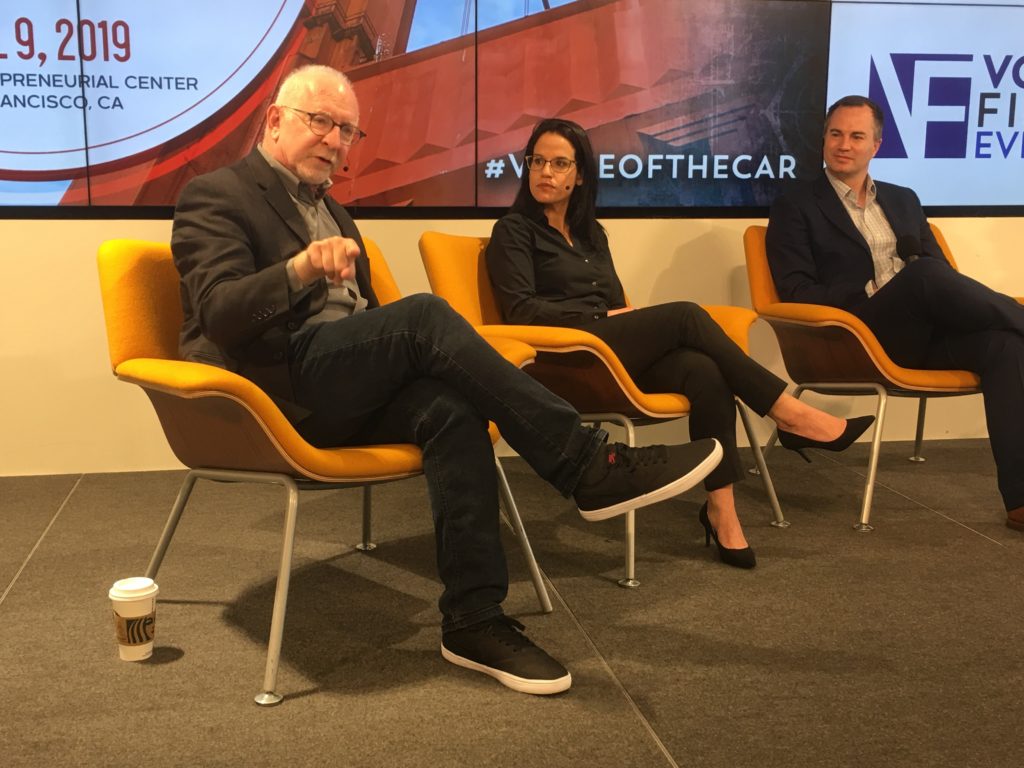 More and more, consumers are using their voices – not just in their homes, but in their cars – to access desired content.
More and more, consumers are using their voices – not just in their homes, but in their cars – to access desired content.
Smart speakers and voice: Why radio struggles.
Already, the following automakers are “baking” Amazon Alexa into their new models:
Ford, Lexus, Toyota, Audi, BMW, Lincoln, and others.
If in-car adoption continues at its current rate – and there’s no reason to believe it won’t – voice will become a central way drivers and passengers access audio while in their vehicles.
Add to that Amazon has pre-sold more than 1 million Echo Auto units – an after-market devices that brings Alexa technology to older vehicles.
You can foresee a time when radio presets become a thing of the past. And as that day approaches, radio operators will once again have to market their calls letters/frequencies to ensure consumers use the correct voice commands.
This sounds a lot like the “diary days” when top-of-mind awareness was THE THING in radio. And yes, this means radio companies will have to start marketing their brands with regularity, just like they did in the good old days. It could prove to be a great time to be an outdoor company.
And it sure wouldn’t hurt broadcast radio to be more visible in the local marketplace.
And few radio stations have devoted resources toward creating dedicated content for smart speakers, choosing instead to simply provide a stream. But some of the cleverest brands have taken advantage of their assets to create skills and content that are enchanting and enjoyable.
Oprah Magazine is a case in point, provideing O! To Go segments, voiced by Oprah. That leverages what she does best – tells inspiring stories – in an environment that’s personal and very one-to-one.

The wildly popular “Jeopardy” skill is another example of strategically smart use of the technology to satisfy currrent fans, as well as reach out to new ones on the platform. The show was early on the Alexa platform (sound familiar?) and came up with the perfect way for Alexa users to engage with the show.
Neither Oprah nor “Jeopardy” is monetizing these skills. They are being used to expand their presence in the Alexa ecosphere, delighting their respective fan bases. The payback comes in the form of increased loyalty, brand strength, word of mouth, and connectedness.
What’s hot? Connected cars.
Nothing new here, because this has been a platform we glommed onto early. And it just gets more interesting – and challenging – with each passing year. As already discussed, the invasion of voice – many “languages” – in cars means most drivers will figure out the best way to get their desired audio entertainment/information.
And the good news is that broadcast radio is very much in the hunt. It currently dominates the dash (although nowhere near as much as it used to). Part of radio’s advantage in cars is its ease of use and habit. That moment when we got our learner’s permit, fastened our seat belt, started the car, and turned on the radio is etched in our crania.
Connected cars: Why radio struggles.
Our Techsurvey research clearly shows that when a consumer buys a connected car, her media world behind the wheel changes. That means less broadcast radio listening and more satellite radio. We think part of the reason SiriusXM is the apparent winner is that it’s as easy to discover, preset, and listen to its channel lineup as it is AM/FM radio. In time, we expect streaming music services, talking books, and podcasts to also encroach on broadcast radio.
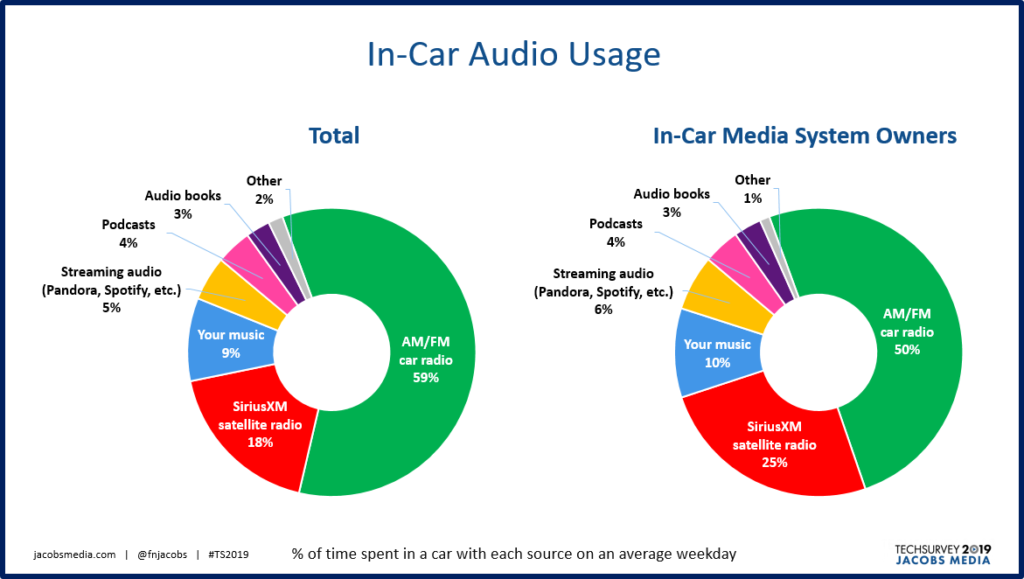
Yet, just about every terrestrial station – even those that conduct regular research – remain fixated on the other radio stations in town as key competitors, often neglecting or ignoring everyone else. In much the same way public radio flew under the ratings radar pre-PPM, most broadcasters just don’t consider much outside of their traditional competitors.
Given that the majority of broadcast radio listening takes place in cars (and we’re actually watch the percentage climb), it would behoove radio to give more serious (no pun intended) thought to the dashboard, especially cars that are connected.
Another Techsurvey takeaway involves the 10% of respondents who tell us they’ve been listening to less radio in the past year. The #1 culprit? Of the ones we supplied, “I have more options to listen to in the car” is the winner, mentioned by more than four in ten of those spending less time with radio in the past twelve months.
As we’ve pointed out in the past, how your station looks on dash displays is also important. An audit the NAB conducted a couple years back in Philly, Charlotte, and Grand Rapids revealed many AM/FM stations look bad – especially up against entertainment and information from streaming platforms and SiriusXM. There’s more information available about how to clean up your dashboard act here.
So, yes audio IS hot. And there’s more of it to choose form than perhaps at any time in the history of electronic and digital media. How successfully radio broadcasters can figure out how to best navigate new platforms is the big question facing every operator, from iHeart to mom & pops.
The NAB continues to address all these audio oppportunities and challenges. At this week’s Vegas show, there were multiple sessions devoted to all areas of the audio spectrum. That will no doubt continue through the Radio Show this fall.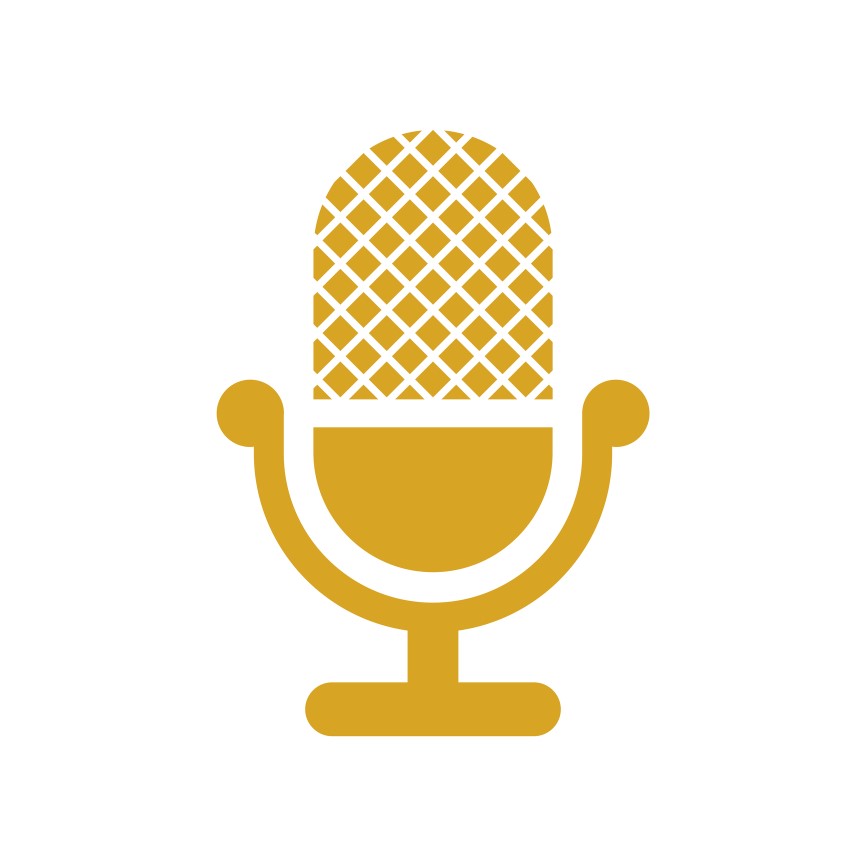
But the net net on all the hoopla surrounding the audio renaissance is that radio broadcasters won’t be able to easily intuit their way to success. There’s more to mastering podcasting, voice, and the connected car than routine activities like signing on a new radio station or running a sales contest.
For radio to participate in what promises to be the next Golden Age of Audio, it will require planning, investment, focus, expertise – and patience. Most have been in short supply since the turn of the millennium.
Given the rapid pace of media and technological change, holding off on popping those champagne corks would seem to be the right thing to do.
We’re hosting a free webinar – “The 10 Things We Learned From Techsurvey 2019” – on Monday, April 15 at 2pm ET. Sign up info here.
- Like A Pair Of Old Jeans - April 2, 2025
- What’s Fair Is Fair - April 1, 2025
- What’s On Your Bucket List? - March 31, 2025




Corks will pop when there’s a new worst to first. It’s Smart Speaker Connection to what makes radio great: Information, Music, Entertainment, Live & Local. It’s not that hard nor costly. Just a matter of doing it with an excellent, experienced curator.
Agree, Clark. Many thanks.
BBC radio is government funded but their on air personalities make it all work on all variants.
They are well informed , can break a music format to talk about serious topics.
Radio in America continued to split apart by creating networks of “all talk”. Ratings and fast upfront money were driving that hard spit.
Now the music folks cannot talk and the talkers do no know music.
Question becomes what network can risk failure for the idea of reuniting them for a small chance of rebuilding .
Frankly, it won’t happen.
Community radio and small low band stations will be the last stronghold of the radio legacy.
That is nearly done 100 % gratis.
Steve, great comments and observations here. Your thoughts amplify what James Cridland talked about on our NAB panel. Thanks for engaging and reading our blog.
A couple of things:
IN the late 80’s I managed 2 medium markets, they were 257 miles apart and I drove between them weekly. During my drives I started, out of desperation, to listen to NPR. Turned out I loved it. Even the smallest markets did a great job during their local news segments. They were killing the local commercial stations. Later when I returned to a top ten market, I’d bring up NPR with my fellow broadcasters, they’d just laugh. They aren’t laughing now are they?
In my final radio go around, I had dinner one night with a bunch of 20 somethings, a kind of focus group with beer and food. Their reaction to radio was, “Why do people on the radio talk about “shit” they know nothing about?” The World Series was in full swing and their complaint was “XXX in the morning doesn’t know “shit” about baseball and he tries to pretend he does. XXX sounds like an idiot. If radio is going to get into podcasting it better have people who know “shit” doing the podcasts
Podcasting – done well, of course – requires smarts, focus, and expertise. The most entertaining and informative ones bring those qualities. Appreciate the comment and the “focus group results.”
Giggle of the day had to be the typo changing “Audi” to “Audio”! Thanks for a great column, as always, and for the extra, always welcome, giggle!
Oy. Thanks for pointing this out, and glad it made you chuckle. I hate and fear typos, so I’ve fixed this one. Thanks for reading the blog & engaging, Dave.
Fred,
When you mentioned earlier this week that you are a “Glass half empty” type of guy and your brother Paul is a “Glass half full” type of guy, you were absolutely correct.
I truly enjoy reading the blogs, but I got to say, they tend to read kind of like the 10 O’clock news, mostly Doom and Gloom, for radio.
I could point out other areas of “death be to radio” but for space sake, I will focus on a paragraph above where you wrote, “We think part of the reason SiriusXM is the apparent winner is that it’s as easy to discover.”… SiruisXM is the clear winner – at 25% compared to radio’s 50% – REALLY! Only 10% of the population even has SiruisXm and that hasn’t changed in years.
Radio is doing pretty well, all things considered! I am not suggesting that we rest on our laurels and I agree that we need to innovate and keep our eye on the competition and the prize but dang, we are doing better than Print, TV, SiruisXM, CD’s, 8-Tracks, Records, etc, etc.
Your bright shiny object is Podcasting, and while I see a bright future for it, it’s a long, long ways from reaching radios stature. If you do the math (averages), 25% of Pop. or 280,000,000 people (12+) listen to a Podcast weekly = 70,000,000 div/by 700,000 Podcast = approximately100 people that listen to each podcast in America. Podcasting, in my opinion, is going to suffocate itself. Sure, those with great content will do fine, and Podcasting as a hobby might bring some joy into a few peoples lives, but will it surpass radio.
I am betting on Radio.
One of Radio’s greatest problems over the years has been its inability to promote itself. I am surprised at the # of radio stations that do not run “real” listener testimonials and “real” advertiser testimonials. (you have written on this topic many times).
Unless beating up on the radio is more profitable from a “Survey and research standpoint”, I hope in the future that you are at least more pro radio than you are a doom and gloom guy. in your blogs.
But I am a “Glass Half Full” guy. Tell Paul Hi for me!
Rick, I appreciate the comment (and your exchange with Ken Dardis). This is one of the things I wish happened more often in the “comments” section. I would just point out one thing – I AM indeed “glass half empty,” but my emphasis (OK, on most days) is a strong belief that broadcast radio can do better. I hope the impact of much of what we talk about is to stimulate a higher standard of content, marketing, and distribution because in order to survive and thrive in this environment, I believe it’s essential. Thanks for taking the time and I will say hi to Paul.
Again, another person who feels defending radio’s status quo is forward movement.
Rick Fink, by bringing up the “Print, TV, SiruisXM, CD’s, 8-Tracks, Records, etc, etc.” argument again you’ve shown how little you understand about the current transition. Generationally, none of the above are close to an analogy of what’s facing radio today.
Think if the industry had taken Google up on its offer to sell inventory in 2006; how far ahead broadcasters would be in knowledge required to work with this new media’s platforms.
The problem was, and continues to be, that radio wants to adjust digital to fit radio’s needs. What must be done is for radio to adjust itself to fit into consumers demands for audio today, on a variety of platforms.
PPM was worthless from the start due to the soon-to-appear wireless earbuds. Companies were warned long before launch that duplicating Groupon (aka: SweatJack) was a waste of time, but time is what execs chose to waste. And since the beginning radio was warned simply regurgitating on-air programs online wouldn’t draw.
Considering how little change in radio programming and advertising we’ve seen, here are two questions to ask anyone in radio: 1) What “new” have you brought back and implemented from this last NAB/Radio Show?; 2) If radio has the “inability to promote itself,” why would an advertiser think it has the ability to promote their product?
In 2013, Larry Rosin, President of Edison Research, said: “It’s not that long ago, when there was a code of omerta in the radio industry, where if you point out a problem, you are the problem.” Mr. Fink, it looks like you want to return to that form of thinking.
Fred needs to keep pointing out these hurdles. They are not getting shorter.
Mr. Dardis,
With all due respect, I believe you are missing the point of my response to Fred.
If you knew me, you would know that I don’t stand for “Status Quo”. I tend to agree with nearly everything you said in your response. In fact, I read a writing of yours from April 2018 (A Metaphor for Podcasting) that stated basically the exact same thing as I did in regards to Podcast. (It was your Saltine Cracker analogy).
Your Point #2, the second to last paragraph is spot on regarding radio not promoting itself. I have said that exact same thing for years. Fortunately, I came from a group that promoted its self and radio, day in and day out, 365 days a year!
My point in responding to Fred was simply, I wish our industry would promote itself more instead of what seems like its promoting the “Doom and Gloom”.
As I stated, I am a “Glass half full” guy. While we need to continue to improve, we are doing pretty well considering all the bombs continually being thrown at us!
Call me and we can visit about this topic sometime!
Ken, thanks for the response to Rick. As I mentioned in my comment to him, I look forward to these momments where passionate people air it out a bit. As always, appreciate you reading the blog & taking the time to weigh in.